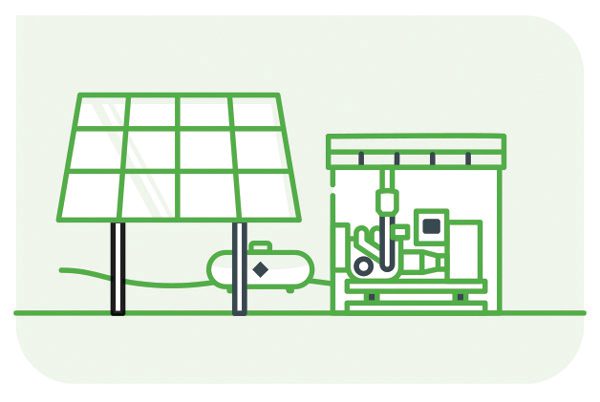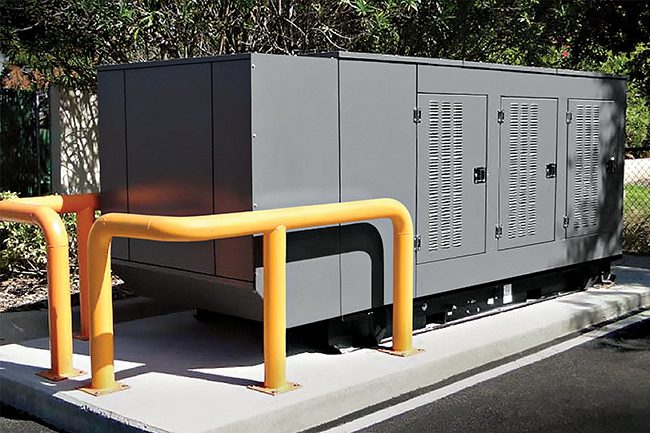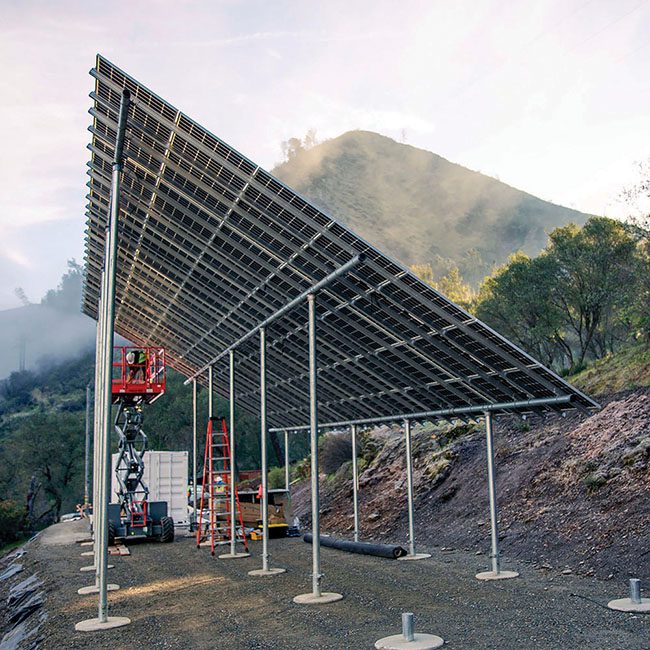Propane Is a Sustainable Choice for Growing Microgrid Need
Construction professionals can rely on propane for lower emissions and enhanced resiliency.
Commercial buildings are experiencing more and more unplanned power outages and it’s causing incredible strain on an already fragile electrical grid. In fact, the U.S. endures more blackouts than any other developed nation. And according to federal databases at the Department of Energy (DOE) and the North American Electric Reliability Corporation (NERC), the number of U.S. outages lasting more than an hour have increased steadily over the past decade. This has construction professionals looking to build more resilient buildings and one way to do that is with microgrids.
 |
|
1. A variety of power generation resources, including solar panels and propane-fueled generators, can be integrated into a microgrid. Courtesy: Propane Education & Research Council (PERC) |
A microgrid is a local energy grid with control capability, which means it can disconnect from the traditional grid and operate autonomously. Within microgrids are one or more kinds of distributed energy—solar panels, wind turbines, combined heat and power (CHP), and/or generators—that produce power during sudden or planned power outages (Figure 1). The quest for a more reliable, secure, and clean energy system is driving investment in microgrid technologies that can deliver superior reliability and resiliency for the nation’s aging and vulnerable grid.
Propane, which is easily transported and stored on-site for indefinite periods of time, offers economic and environmental benefits that make it a great low-carbon energy source for microgrids. The Propane Education & Research Council (PERC) conducted an analysis, The Opportunity for Propane in Microgrids, that illustrates the benefits of using propane generators in hybrid microgrids in commercial applications. Propane offers lower emissions, comparable levelized costs of electricity, and added resiliency compared to diesel generators. Propane generators help minimize the impact of a power outage to a commercial building’s vital systems, such as smoke and fire detection, elevators, refrigeration units, heating and cooling equipment, health and safety equipment, communications, and many other applications.
Propane Is an Environmentally Friendly Energy Source
Whether planned or unplanned, power outages can happen at any time. The rise of power outages is seen in storm-wrecked coastal areas, inland tornado alleys, and particularly in places like California and Texas with increased penetration of renewable energy.
In response to more frequent outages, there’s been a spike in generator sales. Specifically, there has been an increase in the sale of diesel-fueled generators. For many years, diesel has been the chosen generator fuel. As more and more diesel generators are being purchased, their harmful emissions are impacting local communities. According to data from PERC, propane is the better option and can help lower emissions.
 |
|
2. Propane-fueled generators can displace diesel generators in many markets and significantly improve air quality, mainly by lowering the release of nitrogen oxides and particulate matter into the air. Courtesy: PERC |
A study from PERC called Power Generation: The Emissions Shifting Problem looks at the recent trends in power generation, microgrids, and how propane systems can offer a low-emissions and resilient solution for commercial construction professionals and their customers (Figure 2). Compared to diesel, propane significantly improves local air quality by mitigating nitrogen oxides and particulate matter, which are known health hazards. Propane also emits significantly less carbon than diesel-fueled generators. According to the U.S. Energy Information Administration (EIA), propane is 16% cleaner than diesel when it comes to CO 2 per unit of energy.
Microgrids that utilize propane as an energy source get even cleaner when renewable propane is considered. Renewable propane is derived from the processing of agricultural products such as vegetable oil and animal fat, meaning that combustion of renewable propane is net carbon neutral and does not contribute to elevated atmospheric carbon levels like the combustion of fossil fuels. Because renewable propane’s chemical structure and physical properties are the same as propane produced from fossil fuels, renewable propane can be used for all the same applications. As contractors continue integrating backup power solutions, including microgrids, propane should be considered as the energy source of choice to keep buildings operating and emissions reduced.
Propane Is a Safe and Resilient Energy Source
Microgrids help improve the resiliency of local electricity distribution systems, that’s part of why they’re growing in popularity. They represent a groundbreaking approach that has helped solve several of the problems facing cities across the U.S.
 |
|
3. Utilities are finding it safer and more economical to install microgrids with solar and propane-fueled backup systems in remote areas rather than upgrading transmission lines to mitigate wildfire concerns. Courtesy: PERC |
To provide an alternate power solution to customers located in Mariposa County, solar energy company BoxPower and generator manufacturer Generac provided solar PV with battery backup and a propane generator as a solution to reduce wildfires in one of California’s high-risk areas. Instead of ruggedizing the transmission and distribution (T&D) lines, which could cost more than $1 million per mile in remote locations, electric utilities deenergized the T&D lines and installed these microgrid solutions to avert forest fires (Figure 3).
Last year, nearly 800,000 people across the U.S. woke up without power on the morning of Christmas Eve following Winter Storm Elliot. The power went out in portions of Long Island, New York, and a Public Service Electric & Gas (PSE&G) utility line that fed a local grocery store was impacted.
Luckily, a microgrid made up of two propane-powered CHP units that produce 216 kW powered the store, allowing the lights and the refrigerators to stay on, even though nearby buildings went dark. The microgrid’s controls sensed that utility power was out and seamlessly put the microgrid in island mode. During the PSE&G outage, which lasted about 34 hours, the grocery store stayed powered by the microgrid. The store not only was able to sell groceries to the local community but avoided losing food that needed refrigeration.
In addition to providing backup power generation, propane-powered CHP systems can support microgrids by providing district and facility heating, according to data from PERC. CHP systems use a propane-powered engine, a heat exchanger, and a generator to create electricity that powers a building. Simultaneously, the heat from the unit is captured by the heat exchanger and used to channel thermal energy to applications like space heating, water heating, and dehumidification, to name a few. Using both the electrical and thermal output of the propane CHP system achieves system efficiencies as high as 75%.
A CHP system can be used within a microgrid or on its own to create power and heat. CHP units are ideal if on-site power generation has become a high priority, as most systems can be used for standby power during grid-based power outages. Because the unit runs on propane, and many units can start without power from the grid, it offers resilience and energy independence in the event of a power outage without the need for a standby generator.
Propane enables customers to take control of their energy storage. With propane-powered CHP units, customers get all the efficiency of onsite electrical generation with all the efficiency of onsite thermal generation. And, they don’t have to pay a demand charge or peak rate from the electric utility company.
Ultimately, microgrid systems that utilize a propane generator provide peace of mind. Propane power generation equipment used in microgrid applications can help businesses increase safety and resiliency allowing them to retain their clean operation even with a power failure. Propane is an affordable, reliable energy choice capable of delivering efficient, on-site energy at all times. Replacing diesel assets with propane-powered equipment will continue to push us toward significant air quality improvements and decarbonization. To see more of PERC’s research supporting the benefits of using propane in microgrid applications, visit Propane.com/Research.
—Jim Bunsey ([email protected]) is the director of commercial business development at the Propane Education & Research Council.